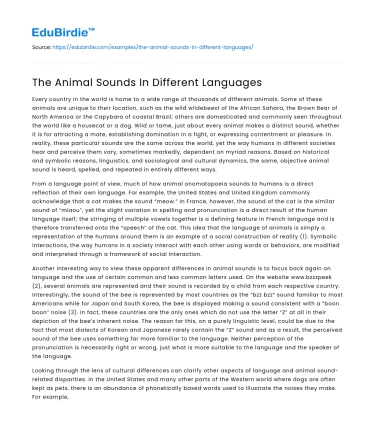Every country in the world is home to a wide range of thousands of different animals. Some of these animals are unique to their location, such as the wild wildebeest of the African Sahara, the Brown Bear of North America or the Capybara of coastal Brazil; others are domesticated and commonly seen throughout the world like a housecat or a dog. Wild or tame, just about every animal makes a distinct sound, whether it is for attracting a mate, establishing domination in a fight, or expressing contentment or pleasure. In reality, these particular sounds are the same across the world, yet the way humans in different societies hear and perceive them vary, sometimes markedly, dependent on myriad reasons. Based on historical and symbolic reasons, linguistics, and sociological and cultural dynamics, the same, objective animal sound is heard, spelled, and repeated in entirely different ways.
From a language point of view, much of how animal onomatopoeia sounds to humans is a direct reflection of their own language. For example, the United States and United Kingdom commonly acknowledge that a cat makes the sound “meow.” In France, however, the sound of the cat is the similar sound of “miaou”, yet the slight variation in spelling and pronunciation is a direct result of the human language itself; the stringing of multiple vowels together is a defining feature in French language and is therefore transferred onto the “speech” of the cat. This idea that the language of animals is simply a representation of the humans around them is an example of a social construction of reality (1). Symbolic interactions, the way humans in a society interact with each other using words or behaviors, are modified and interpreted through a framework of social interaction.
Save your time!
We can take care of your essay
- Proper editing and formatting
- Free revision, title page, and bibliography
- Flexible prices and money-back guarantee
Another interesting way to view these apparent differences in animal sounds is to focus back again on language and the use of certain common and less common letters used. On the website www.bzzzpeek (2), several animals are represented and their sound is recorded by a child from each respective country. Interestingly, the sound of the bee is represented by most countries as the “bzz bzz” sound familiar to most Americans while for Japan and South Korea, the bee is displayed making a sound consistent with a “boon boon” noise (3). In fact, these countries are the only ones which do not use the letter “Z” at all in their depiction of the bee’s inherent noise. The reason for this, on a purely linguistic level, could be due to the fact that most dialects of Korean and Japanese rarely contain the “Z” sound and as a result, the perceived sound of the bee uses something far more familiar to the language. Neither perception of the pronunciation is necessarily right or wrong, just what is more suitable to the language and the speaker of the language.
Looking through the lens of cultural differences can clarify other aspects of language and animal sound-related disparities. In the United States and many other parts of the Western world where dogs are often kept as pets, there is an abundance of phonetically based words used to illustrate the noises they make. For example, the words “bow-wow”, “arf arf”, “woof”, “yip”, “yap”, and “ruff-ruff”, barely graze the surface of these types of sounds, whereas in other cultures, which may not enjoy the same relationship Americans have with their dogs, there may be just one or two dog sound descriptions. The idea that Americans place such a high social status on their dogs as pets likely relates to the fact that there are so many ways to describe their sounds. However, the dog is only as valuable as the humans in society make it to be. Though Americans may think of this as the cultural norm, other cultures do not. This is again not right nor wrong, yet it is a great example of cultural relativism; just because one culture places importance on some ideology or thought does not necessarily mean that is of the same importance across the board. Imagining that one culture’s perception of an animal’s sound is better or somehow more precise is not simply unfair, but also ethnocentric.
Exposure to certain animals allows people a better grasp on the sound they make as well. As an example, most Americans would struggle to mimic the sound of a camel as it is not an animal most people in the U.S. would have seen in person or been presented to in the media. Cultures who live in the Middle East, North Africa or parts of Central Asia might have several unique noises they associate with the camel because it is an animal they have experience with (4). The theory of symbolic interactionism supports this idea that the way we interact with one another uses words and behaviors that have a shared meaning (1). To Americans, the sound that a camel makes lacks a reference point which might be present in Middle Eastern cultures.
It is likely that the children performing these animal sounds have little conscious knowledge that their interpretations would possibly sound any different than a child living in another culture. The sounds they have assigned to each animal are simply the ones they have heard growing up from their parents, schools, and peers. The fact that some of these animal sounds vary so widely in pronunciation and spelling has far more to do with language and symbolic interactionism than any real concrete differences in the animals themselves. The importance a culture places on certain animals may give them more words to describe and express themselves. The symbolism of the animal sounds are not intrinsically created, rather they are a social construction, a product of human relations and interactions.






 Stuck on your essay?
Stuck on your essay?

